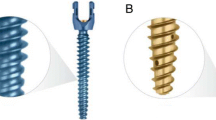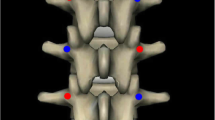Abstract
Background
Biomechanical studies have shown C2 pedicle screw to be the most robust in insertional torque and pullout strength. However, C2 pedicle screw placement is still technically challenging. Smaller C2 pedicles or medial localization of the vertebral artery may preclude safe C2 pedicle screw placement in some patients. The purpose of this study was to compare the pullout strength of spinous process screws with pedicle screws in the C2.
Materials and Methods
Eight fresh human cadaveric cervical spine specimens (C2) were harvested and subsequently frozen to–20°C. After being thawed to room temperature, each specimen was debrided of remaining soft tissue and labeled. A customs jig as used to clamp each specimen for screw insertion firmly. Screws were inserted into the vertebral body pairs on each side using one of two methods. The pedicle screws were inserted in usual manner as in previous biomechanical studies. The starting point for spinous process screw insertion was located at the junction of the lamina and the spinous process and the direction of the screw was about 0° caudally in the sagittal plane and about 0° medially in the axial plane. Each vertebrae was held in a customs jig, which was attached to material testing machine (Material Testing System Inc., Changchun, China). A coupling device that fit around the head of the screw was used to pull out each screw at a loading rate of 2 mm/min. The uniaxial load to failure was recorded in Newton’st dependent test (for paired samples) was used to test for significance.
Results
The mean load to failure was 387 N for the special protection scheme and 465 N for the protection scheme without significant difference (t = −0.862, P = 0.403). In all but three instances (38%), the spinous process pullout values exceeded the values for the pedicle screws. The working distances for the spinous process screws was little shorter than pedicle screws in each C2 specimen.
Conclusion
Spinous process screws provide comparable pullout strength to pedicle screws of the C2. Spinous process screws may provide an alternative to pedicle screws fixation, especially with unusual anatomy or stripped screws.
Similar content being viewed by others
References
Grob D, Jeanneret B, Aebi M, Markwalder TM. Atlanto-axial fusion with transarticular screw fixation. J Bone Joint Surg Br 1991;73:972–6.
Kansal R, Sharma A, Kukreja S. An anterior high cervical retropharyngeal approach for C1-C2 intrafacetal fusion and transarticular screw insertion. J Clin Neurosci 2011;18:1705–8.
Deen HG, Birch BD, Wharen RE, Reimer R. Lateral mass screw-rod fixation of the cervical spine: A prospective clinical series with 1-year follow up. Spine J 2003;3:489–95.
Ebraheim N, Rollins JR Jr, Xu R, Jackson WT. Anatomic consideration of C2 pedicle screw placement. Spine (Phila Pa 1976) 1996;21:691–5.
Goel A. C1-C2 pedicle screw fixation with rigid cantilever beam construct: Case report and technical note. Neurosurgery 2002;51:853–4.
Resnick DK, Lapsiwala S, Trost GR. Anatomic suitability of the C1-C2 complex for pedicle screw fixation. Spine (Phila Pa 1976) 2002;27:1494–8.
Wright NM. Posterior C2 fixation using bilateral, crossing C2 laminar screws: Case series and technical note. J Spinal Disord Tech 2004;17:158–62.
Nagata K, Baba S, Chikuda H, Takeshita K. Use of C2 spinous process screw for posterior cervical fixation as substitute for laminar screw in a patient with thin laminae. BMJ Case Rep 2013;24;2013.
Jones EL, Heller JG, Silcox DH, Hutton WC. Cervical pedicle screws versus lateral mass screws. Anatomic feasibility and biomechanical comparison. Spine (Phila Pa 1976) 1997;22:977–82.
Kim SM, Lim TJ, Paterno J, Hwang TJ, Lee KW, Balabhadra RS, et al. Biomechanical comparison of anterior and posterior stabilization methods in atlantoaxial instability. J Neurosurg 2004;100:277–83.
Kuroki H, Rengachary SS, Goel VK, Holekamp SA, Pitkänen V, Ebraheim NA. Biomechanical comparison of two stabilization techniques of the atlantoaxial joints: Transarticular screw fixation versus screw and rod fixation. Neurosurgery 2005;56:151–9.
Melcher RP, Puttlitz CM, Kleinstueck FS, Lotz JC, Harms J, Bradford DS. Biomechanical testing of posterior atlantoaxial fixation techniques. Spine (Phila Pa 1976) 2002;27:2435–40.
Lapsiwala SB, Anderson PA, Oza A, Resnick DK. Biomechanical comparison of four C1 to C2 rigid fixative techniques: Anterior transarticular, posterior transarticular, C1 to C2 pedicle, and C1 to C2 intralaminar screws. Neurosurgery 2006;58:516–21.
Jeanneret B, Magerl F. Primary posterior fusion C1/2 in odontoid fractures: Indications, technique, and results of transarticular screw fixation. J Spinal Disord 1992;5:464–75.
Harms J, Melcher RP. Posterior C1-C2 fusion with polyaxial screw and rod fixation. Spine (Phila Pa 1976) 2001;26:2467–71.
Parker SL, McGirt MJ, Garcés-Ambrossi GL, Mehta VA, Sciubba DM, Witham TF, et al. Translaminar versus pedicle screw fixation of C2: Comparison of surgical morbidity and accuracy of 313 consecutive screws. Neurosurgery. 2009;64 Suppl 2:343–8.
Park JS, Cho DC, Sung JK. Feasibility of C2 translaminar screw as an alternative or salvage of C2 pedicle screws in atlantoaxial instability. J Spinal Disord Tech 2012;25:254–8.
Gorek J, Acaroglu E, Berven S, Yousef A, Puttlitz CM. Constructs incorporating intralaminar C2 screws provide rigid stability for atlantoaxial fixation. Spine (Phila Pa 1976) 2005;30:1513–8.
Jea A, Sheth RN, Vanni S, Green BA, Levi AD. Modification of Wright’s technique for placement of bilateral crossing C2 translaminar screws: Technical note. Spine J 2008;8:656–60.
Liu GY, Xu RM, Ma WH, Sun SH, Lin HJ, Feng JX, et al. Anatomic comparison between spinous process screws and pedicle screws techniques of the second cervical vertebar. Zhongguo Gu Shang 2011;24:659–61.
Liu GY, Xu RM, Ma WH, Sun SH, Feng JX, Hu Y, et al. Anatomical considerations for the placement of C2 spinous process screws. Zhonghua Wai Ke Za Zhi 2010;48:1653–6.
Su BW, Shimer AL, Chinthakunta S, Salloum K, Ames CP, Vaccaro AR, et al. Comparison of fatigue strength of C2 pedicle screws, C2 pars screws, and a hybrid construct in C1-C2 fixation. Spine (Phila Pa 1976). 2014;39:E12–9.
Heller JG, Estes BT, Zaouali M, Diop A. Biomechanical study of screws in the lateral masses: Variables affecting pull-out resistance. J Bone Joint Surg Am 1996;78:1315–21.
Author information
Authors and Affiliations
Corresponding author
Rights and permissions
About this article
Cite this article
Liu, Gy., Mao, L., Xu, Rm. et al. Biomechanical comparison of pedicle screws versus spinous process screws in C2 vertebra. IJOO 48, 550–554 (2014). https://doi.org/10.4103/0019-5413.144212
Published:
Issue Date:
DOI: https://doi.org/10.4103/0019-5413.144212




